Touvelle State Recreation Site Acorn Granary
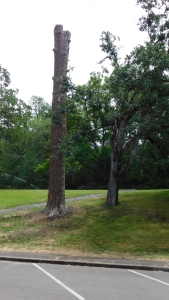
Touvelle Granary Tree — at a distance
Many Oregonians are familiar with Acorn Woodpeckers, which are easily recognizable by their clownish black and white faces, red heads, and noisy calls. They live in social groups and have an interesting mating system that involves multiple males and females sharing one nesting cavity and raising chicks together.
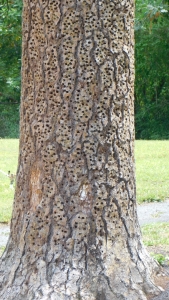
Touvelle Granary Tree — much closer
Acorn Woodpeckers also share their food storage systems, called granaries. According to Cornell’s Bird Academy, each woodpecker “…group works together to maintain and defend its acorn collection…reused over generations to store the winter food supply.” Granaries are not rare, but the Touvelle State Recreation Site, which runs adjacent to the Rogue River east of White City, houses an especially impressive one, with thousands of acorns inserted from the top of the tree to the bottom. It is easily found near the parking lot. Drive to the far end of the lot and face the restrooms located at the top of the hill that edges the lot. The tree — a dead trunk devoid of limbs — is located to the left of the restrooms, not far from curb.
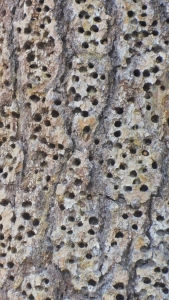
Touvelle Granary close-up
Although not odd, the rest of the Recreation Site is worth a visit. There is an easily walkable nature trail that winds along the side of the river, and then loops through meadows and a seasonal wetland. It is a good place to look for winter birds, swallows in the summer, and the ubiquitous woodpeckers. A nice place to picnic, there are picnic tables and benches. It is quiet during weekdays. A $5.00 entrance fee is charged.
Manor resident readers can find an even closer granary tree. This tree, located at the side (library) entrance into the Manor Building, has become a beloved natural icon, and a spirited and successful protest was launched when consideration was being given to removing the tree. Granted, the tree is dead and several limbs have been removed or fallen off. Its days are numbered so locals should enjoy it along with the Acorn Woodpeckers that may frequently be seen on the tree. This more humble tree also is pictured below. — Anne
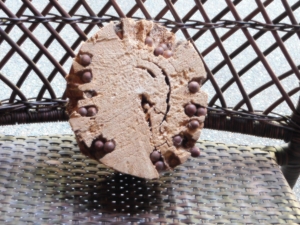
Cross section, Bear Creek Park granary tree
I don’t know that I consider the tree more humble —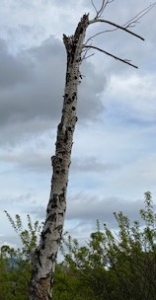 dilapidated, perhaps. The RVM granary tree is shown at right. To provide some detailed anatomy, the other pictures (at left and below) show two views of a section cut from a granary tree that was felled in Bear Creek Park. Real snacks for acorn-eaters. Who are the other local consumers? Squirrels and other rodents, although they might have trouble getting around the defenses of a “social group” (a.k.a. militia) of woodpeckers. Turkeys like acorns, but only the ones that fall in the streets where the cars crush the shells. And bears. Do woodpeckers attract bears? I don’t know, but if I come upon a tree that has big scratch marks as well as little holes containing acorns, I will probably redirect my nature study to some other location. — Bob
dilapidated, perhaps. The RVM granary tree is shown at right. To provide some detailed anatomy, the other pictures (at left and below) show two views of a section cut from a granary tree that was felled in Bear Creek Park. Real snacks for acorn-eaters. Who are the other local consumers? Squirrels and other rodents, although they might have trouble getting around the defenses of a “social group” (a.k.a. militia) of woodpeckers. Turkeys like acorns, but only the ones that fall in the streets where the cars crush the shells. And bears. Do woodpeckers attract bears? I don’t know, but if I come upon a tree that has big scratch marks as well as little holes containing acorns, I will probably redirect my nature study to some other location. — Bob
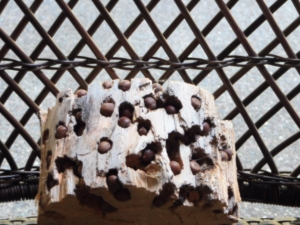
Side view, section of Bear Creek Park granary tree


Leave a Reply
Want to join the discussion?Feel free to contribute!